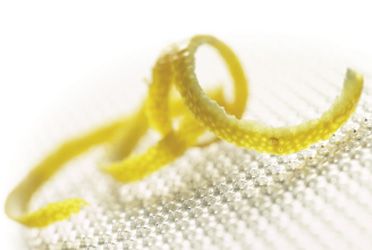Grate flavor
Citrus peel adds zest to foods - and health
Susan Felt
The Arizona Republic
Feb. 13, 2008 12:00 AM

A few scrapes of the grater across a scrubbed orange, lemon, grapefruit or lime and you've not only created a little zest for almost any dish, but you've also added cancer-fighting ingredients such as d-limonene.
Who knew?
Zest, the tiny, colorful scrapings of citrus peel that chefs toss into sauces, soups, dough and batter, is also a potent source of vitamin C and the powerful antioxidant d-limonene.
Zest is among superfoods like blueberries, white tea, pomegranates, leafy green vegetables, red wine and dark chocolate touted for their antioxidant qualities.
In a study by Iman Hakim, professor of public health at the University of Arizona College of Public Health and Arizona Cancer Center, she says citrus peel has 10 times more d-limonene than "any juice on the market." The peel is where the cancer-preventing citrus oil is concentrated, she says.
But it's the micro-thin citrus peel's flavor more than its health credentials that attracted Garrison Whiting, a chef at Zest Spirited Dining (really) in Phoenix.
Whiting can't remember a time when he didn't add zest to the dishes he has been making since age 15. His playground was the demonstration kitchen at Kitchen Classics, a cooking-class and food-equipment store in Phoenix owned by his mother, Shauna Halawith, and where his brother, chef J. Whiting, teaches cooking.
Garrison Whiting adds lime zest to salsa and lemon zest to risottos, sorbets, salads and anything else whose taste he wants to brighten.
"It's the most powerful flavor of citrus in the smallest amount," the 21-year-old chef says.
And citrus zest is nearly foolproof. Adding orange juice to a dish not only introduces more liquid you may not need, it can also add more bitterness or sweetness to a dish if it cooks too long.
But fresh zest, like salt, enhances the flavor by adding its undiluted essence.
"It's fresh and bright, and reminds you of sunshine and all good things in the world," Whiting says.
Like all good things, creating zest takes the right tool and technique. Too often people use a grater, paring knife or peeler to slice off the colorful skin, which guarantees adding pith to the zest.
Whiting recommends using a microplaner, a long razor-sharp stainless-steel rasp to create zest. Don't use a box grater. It's too easy to grab the fruit's bitter white pith, not to mention your knuckles. Plus, the zest usually gets caught in the fine grater slots.
The trick to zesting is to roll the fruit as you go from the top to the bottom of the microplaner. Go in one direction, not back and forth.
Run the fruit down the microplaner, snagging only the colored part of the peel.
"Don't stay in one spot," Whiting warns.
You can seal the fruit in plastic wrap to juice or use later.
Cookbook author Lori Longbotham touts the virtues of zest, in particular lemon zest, in her book Lemon Zest (Broadway, 2002, $16.95 paperback).
She writes, "Pungent with natural aromatic oils, the zest imparts a freshness and a subtle yet lively layering of flavors, with its complex taste of floral and tangy tones as well as a slight, sophisticated bitterness."
She tosses lemon zest into recipes that call lemon juice.
"The zest contains more lemon flavor and adds an invigorating lightness and sharpness to a dish and will not affect the balance of the recipe's other ingredients," she says.
Longbotham suggests using fresh or frozen zest rather than commercially dried zest because the latter usually has lots of preservatives and little fresh-lemon flavor.
She recommends freezing or drying your own zest, whether lemon or other citrus flavors. (See accompanying directions for drying zest.)
Whiting adds orange zest to osso buco, lime zest to ahi-tuna salad and grapefruit zest to a sorbet. He recommends tossing lemon zest into chicken and noodle soup. Or some orange zest into Turkish coffee.
In a recent cancer study at the University of Arizona, adding 1 teaspoon of zest to a cup of hot black tea was credited with reducing skin cancer by more than 70 percent. Hakim says the research she is currently conducting indicates that citrus peel is equally effective in reducing the risk of breast cancer.
But for chefs like Whiting and Longbotham, the benefit of citrus zest is being able to add a splash of sunshine into an otherwise merely pleasant-tasting dish.
Source:
http://www.azcentral.com/arizonarepublic/food/articles/0213fdzest0213.html 





